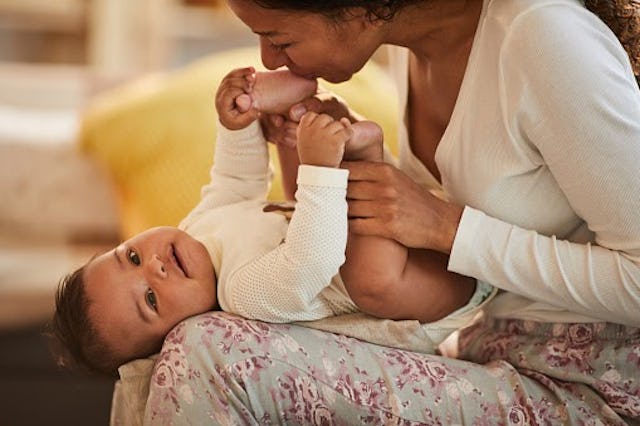If You Haven’t Heard of RSV, Here Are 4 Things To Know About This Common Infant Illness

Keeping your kids safe and healthy during winter can be tough, especially this year, but understanding the causes of common illnesses may help in preventing them. One winter-time infection you may not have heard about? Respiratory Syncytial Virus.
Respiratory Syncytial Virus, or RSV, is a common respiratory virus among infants. 1 For many, recovering from RSV only takes a week or two, and, in some cases, may not even require a visit to the doctor. However, for some infants and young children, the virus can be especially serious requiring medical care or even hospitalization.1
RELATED: Baby Congestion: What To Do, When To Worry, And When It’s Just Snot
RSV generally causes symptoms similar to a mild cold, like coughing and a runny nose, so if you’ve got a little one, you’ll want to take note. 2 Here are four things to know.
A Common Virus Parents Often Don’t Know About
RSV is incredibly widespread. In fact, nine out of 10 infants will be infected with RSV before they turn two.3,4 We mention this less to freak you out and more to reassure you that if your baby catches RSV, it is in no way an indication of your parenting skills, and in most cases, should not be a cause for alarm or distress, unless the infection progresses in severity. (This is a non-shaming mom zone but be aware that infants are most at risk for severe infection during their first RSV season — those first winter months.)
In other words, virtually all babies are at risk for contracting RSV. While it’s extremely common and most infections may be mild, some cases of RSV can be quite serious. In fact, RSV is the leading cause of hospitalization in babies; 1 to 2% of children under 6 months of age with RSV may need hospitalization.1 Additionally, most babies hospitalized due to RSV are otherwise healthy and born at full term, which shows us the unpredictability of severe disease.5,6,7
Stay Aware: RSV Can Start Out Looking Like A Cold But Symptoms May Progress
RSV may begin as cold-like symptoms like coughing, sneezing, a runny nose or a decrease in appetite.1 Children infected with RSV may also show symptoms such as wheezing, difficulty breathing and fever — symptoms generally appear four to six days after exposure.1,2 Young infants may also experience irritability and decreased activity.1 RSV is the leading cause of acute lower respiratory tract infections, like pneumonia and bronchiolitis, so consult your pediatrician, if you observe your child having difficulty breathing or experiencing worsening symptoms.2,3,8
Here is What You Can Expect When You See Your Health Provider for Possible Severe RSV
A typical type of monitoring begins with your healthcare provider listening to your child’s lungs with a stethoscope to check for wheezing.9
Laboratory tests are not typically ordered, but if they are, they may include blood tests to check for white blood cell count; nose swabs; or skin monitoring with a pulse oximeter to detect lower than normal levels of oxygen in the bloodstream.
You’re Probably Already Taking Steps To Help Prevent RSV — Keep It Up!
You should know you can take some steps toward RSV prevention. First and foremost, wash those hands! By now, you should be more than familiar with the 20-second rule for hand washing. In addition to helping prevent the spread of COVID-19 and the flu, consistently washing your hands, wearing a mask and maintaining distance will help prevent the spread of RSV and other viruses.1
Regularly disinfecting surfaces, covering your coughs and avoiding contact with people who are ill remain the best ways to keep your child from getting sick.1 Yes, this does mean being extra cautious, but it’s helpful preventive care. Plus, there’s good news: organizations are researching possible preventions for RSV. So, stay informed, stay safe, and keep washing your hands and wearing a mask.
References
- Respiratory Syncytial Virus (RSV): RSV in Infants and Young Children. Centers for Disease Control and Prevention. Accessed January 2021. https://www.cdc.gov/rsv/high-risk/infants-young-children.html
- Respiratory Syncytial Virus (RSV): Symptoms and Care. Centers for Disease Control and Prevention. Accessed December 2020. https://www.cdc.gov/rsv/about/symptoms.html.
- Glezen WP et al. Am J Dis Child. 1986;140(6):543-546
- Collins et al. Journal of Virology. 2008:2040–2055
- Arriola, C, et al. “Estimated Burden of Community-Onset Respiratory Syncytial Virus–Associated Hospitalizations Among Children Aged <2 Years in the United States, 2014–15.” Journal of the Pediatric Infectious Diseases Society. 2019.
- Hall CB, et al. Respiratory Syncytial Virus-Associated Hospitalizations Among Children Less Than 24 Months of Age. Pediatrics, 132(2). doi: 10.1542/peds.2013-0303
- Rha, B et al. Respiratory Syncytial Virus–Associated Hospitalizations Among Young Children: 2015–2016. Pediatrics: 2020. 146 (1) e20193611; DOI: https://doi.org/10.1542/peds.2019-3611.
- Shi T, et al. Global, regional, and national disease burden estimates of acute lower respiratory infections due to respiratory syncytial virus in young children in 2015: a systematic review and modelling study. Lancet 2017; 390: 946–588
- Diseases and Conditions: Respiratory syncytial virus (RSV). NCH Healthcare System. Updated July 2017. Accessed January 2021. https://www.nchmd.org/education/mayo-health-library/details/CON-20309861
This article was originally published on